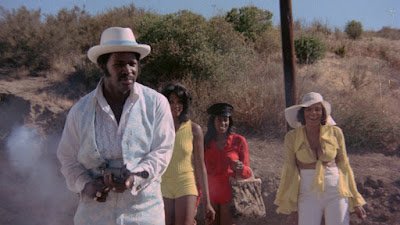The story of enterprising and ribald comedian Rudy Ray Moore, and how he made the outrageous blaxploitation comedy “Dolemite,” is worth retelling for how Moore inhabited a character far larger than life and tastes could allow, recording explicit stand-up albums, leading to films, all forced into life by sheer force of Dolemite’s will, and Moore’s determination. “Dolemite” could never have been a studio project, but popular culture pierced itself on it very quickly once Moore made it himself. The Netflix comedy “Dolemite Is My Name,” stars Eddie Murphy as one of his heroes, with a script by the writers of Tim Burton’s film “Ed Wood,” in a passion project that took fifteen years to complete.
(How is this for six degrees of separation: Rudy Ray Moore starred in “Dolemite,” whose cinematographer, then U.C.L.A. film student Nicholas von Sternberg, was the son of director Josef von Sternberg, who directed Marlene Dietrich in “The Blue Angel” - Dietrich appeared in “Touch of Evil” with Orson Welles, who voiced Unicron in “Transformers: The Movie” alongside Roger Carmel, who appeared in “Myra Breckinridge,” a film less dignified than “Dolemite.”)
I saw “Dolemite Is My Name” and loved it, but the “Ed Wood” story made me wary of one thing. “Dolemite” is as scrappy and rough as its hero, but is also as charming. However, it is also known for a very notorious technical issue, namely the boom microphone wandering into shot from either the top or bottom of the frame. “Dolemite” is known almost as much for its boom mic as for Moore himself, but this is a very unfair slight on Nicholas von Sternberg’s skills as a cinematographer, because if you can see the boom mic at all (or, in a couple of shots, the operator holding the boom), you are not seeing the film as intended.
Much like the “Back to the Future” and “Jurassic Park” trilogies, “Titanic,” “Top Gun,” and many other Hollywood films, “Dolemite” was shot using the “open matte” process, by which you will shoot your film first, using the standard Academy ratio of 1.33:1, and make it widescreen later by blocking out the top and bottom of the frame. While “Dolemite” will have done this in 1974 to save the expense of anamorphic lenses, to squeeze a widescreen picture into the square film frame, open matte would be used in the 1980s and 1990s for when films were shown at home on old-style, non-widescreen televisions – instead of having a “letterboxed” picture, and instead of choosing what parts of the widescreen picture you could see (known as “pan and scan”), you could just show the original film without masking any of it.
The advent of widescreen televisions did away with all of these problems, but open matte was also used to re-present films for different cinema experiences, like IMAX, but it explains TV shows shot on film, like “Friends,” “Seinfeld” and “Cheers,” are now available in widescreen after twenty to thirty years – this time, the picture is just being masked vertically, instead of horizontally. Meanwhile, I do remember grumbles some years ago about not being able to see all the picture on the “Back to the Future” Blu-Ray, in comparison with VHS, but as far as I can see, the version available is the correct one.
So, when “Dolemite” was first released for home video in the 1980s, it should really have been in a “pan and scan” version, and not full screen. There should not have been the opportunity to create drinking games from how often the boom mic could be seen, and while the film isn’t the best ever made, its reputation suffered from not being viewed on its own terms. “Dolemite” is now available on Blu-Ray, in a restored widescreen version – a full-screen “Boom Mic Edition” is an optional extra on the disc.





No comments:
Post a Comment